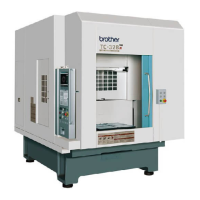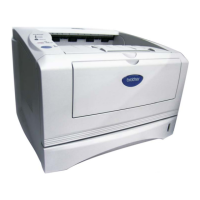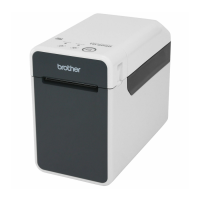
Do you have a question about the Brother TC-32B and is the answer not in the manual?
Explains the general content of a section.
Explains the alert mechanism for dangers and hazards.
Explains procedures for activating functions.
Describes how screen information is presented.
Explains the use of sketches and figures.
Explains main and subprogram structure.
Describes the structure of a program block and words.
Explains the composition of a word with address and value.
Details decimal point programming and address range.
Explains the use and format of sequence numbers.
Describes how to skip blocks using the slash code.
Explains how to insert comments in programs.
Explains machine and working coordinate systems.
Defines machine zero point and coordinate system.
Explains the use of working coordinate systems for workpieces.
Classifies G codes into modal and one-shot types.
Explains tool movement at rapid traverse rate.
Describes linear tool movement at specified feedrate.
Explains chamfering and cornering operations.
Details tool movement along circular or helical paths.
Explains circular path movement with various command formats.
Explains XZ plane circular interpolation commands.
Describes helical cutting by adding axis commands to circular interpolation.
Explains spiral interpolation with increment/decrement per rotation.
Details conical interpolation for spiral movement.
Details cutting circles starting from the center.
Explains how to select the machining plane.
Explains how to ensure tool stops precisely at the end of a block.
Details inputting working zero positions and tool data.
Explains setting allowable travel areas for tool motion.
Explains automatic return to reference point via intermediate point.
Explains how to use machine coordinate system values.
Describes selecting workpiece coordinate systems.
Details enlarging or reducing programmed shapes.
Explains applying mirror image to program commands.
Explains rotating specified program shapes.
Explains specifying axis movement by absolute or incremental values.
Details shifting the working zero point.
Explains moving to target or until detection signal ON.
Details high-speed peck drilling cycle.
Explains tool diameter compensation commands.
Explains moving the tool with offset from actual form.
Describes entering cancel mode after power ON or reset.
Explains entering offset mode when specific conditions are met.
Details tool movement commands within offset mode.
Explains how to exit offset mode using G40.
Explains correcting tool position based on length offset.
Details adding fine offset value to tool length offset.
Provides a list of available canned cycle functions.
Explains the six basic motions in canned cycles.
Covers data format, return levels, and drilling modes.
Provides detailed information on specific canned cycles.
Details high-speed peck drilling cycle.
Explains reverse tapping cycle with spindle control.
Describes basic drilling cycles.
Describes peck drilling cycle with chip breaking.
Explains tapping cycle with spindle control.
Details boring cycles with variable return speeds.
Describes boring cycle with spindle stop at Z point.
Explains back boring cycle with spindle orientation.
Details end mill tapping cycle.
Explains end mill tapping cycle with synchro mode.
Details double drilling cycle with multiple feed speeds.
Explains double boring cycle with variable feed speeds.
Details double boring cycle with speed changeover points.
Explains reducing cutting feed depth gradually.
Explains how to cancel canned cycles.
Explains the non-stop automatic tool change cycle.
Lists available coordinate calculation functions.
Explains parameters for coordinate calculation.
Provides details on specific coordinate calculation functions.
Explains calculation of points on a circular arc.
Details calculating points along a line at an angle.
Explains calculating points with X and Y intervals.
Describes calculating grid points with optional inclination.
Shows examples of using coordinate calculation functions.
Defines macros and their main functions.
Explains the use of variables in macro programming.
Explains how to designate variables and use formulas.
Defines NULL variables and their behavior.
Details local and common variable types and ranges.
Covers calculation types and order of operations.
Lists arithmetic and function-based calculations.
Explains the precedence of operations and use of brackets.
Provides notes on formulas, angles, logic, and accuracy.
Explains changing program flow using GOTO, IF, WHILE.
Describes unconditional branching to sequence numbers.
Explains conditional branching based on formulas.
Details repeating program blocks based on conditions.
Provides guidelines and warnings for control functions.
Explains calling other macro programs.
Details calling a macro program using G65.
Explains automatically calling macro programs with axis movement.
Describes passing local variables to macros via arguments.
Compares G65 macro calls with M98 subprogram calls.
Explains calling macros multiple times within each other.
Instructions for setting necessary parameters before measurement.
Details setting parameters for automatic work measurement.
Explains the operational steps for automatic work measurement.
Details automatic measurement of corners.
Explains how measured results are displayed.
Explains how measured results are displayed.
Explains how measured results update the workpiece coordinate system.
Details operations related to lock keys during measurement.
Introduces the high accuracy mode A function.
Explains how to use and set up high accuracy mode A.
Details setting user parameters for deceleration functions.
Describes the settings for override parameters.
Explains how to use M codes to activate the mode.
Lists G code modal conditions required for the mode.
Explains when the mode is turned off.
Lists functions available and additional axis travel restrictions.
Lists usable G and M codes and C codes.
Describes automatic deceleration functions for corners, arcs, and curves.
Explains automatic deceleration for corners to improve accuracy.
Details automatic deceleration for arcs to maintain accuracy.
Explains automatic deceleration for curve approximation.
Explains how to create a subprogram using M99.
Details calling a subprogram using M98.
Explains how subprograms return control to the main program.
Describes returning control to a specific sequence number.
Explains how the main program jumps to a sequence number.
Explains specifying feedrate using the F address.
Explains using S code for spindle speed.
Details commanding magazine rotation via tool or pot number.
Lists M codes for controlling machine solenoids.
Provides precautions for using rotation axis with specific tables.











